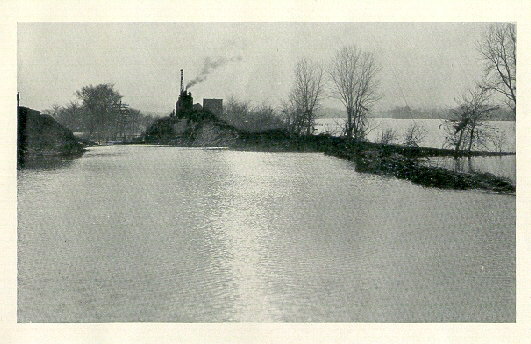

the levee, which caused all the sorrow and misery.
Taken From:
THE GHOST CITY, Story of the LAWRENCEBURG 1937 FLOOD
with pictures
By M. O. Whitney, Lawrenceburg, Indiana
Many compliments and congratulations have been extended on the efforts put forth to make this little publication possible. But few know how great a share deservedly belongs to my companion of thirty eight years "for better or for worse" and no one knows but me, how impossible it would have been for me to surmount what seemed to be unsurmountable obstacles, both mental and physical, had it not been for the fact that she worked shoulder to shoulder, unflinchingly and courageously, through this most terrible experience we ever encountered. From the moment we stepped out of our second story apartment window into a boat to face a blinding blizzard on one of the darkest nights that God ever made, and bade good-bye to practically all of our earthly possessions, while the loath-some slimy monster crept stealthily upon the city which it soon devoured, her courage never faltered. She not only gave me the courage and strength to go ahead, but found time to minister to her fellow sufferers, and succor those who were less able to "take it." All praise to my beloved wife. If ever I paid tribute to any one let it be to her, and now. If your booklet serves to rehabilitate us our efforts will have been rewarded.
Editor's Note:
The publisher of this pictorial story of a part of one
of the greatest catastrophes of all time, does so, knowing the citizens
of Lawrenceburg desire the book as a matter of historic record rather than
a wailing beggar. Lawrenceburg may be downed for a time, but she
is not "licked" for--
'Neath the clothes so soiled and old
There beats a heart as pure as gold.
Lawrenceburg shall arise again.
Edited and Published by M.O. Whitney, Lawrenceburg, Indiana
Disappeared is joy and gladness
Note the poverty and pain;
Oh such misery and sadness,
Time alone can heal again.
Happy homes
gone to destruction,
Joyful lives
are in dismay
By the angry
flood's reduction
On that fearful
fateful day.
Man may combat but not conquer
Elements of God's domain,
And their anger will not encore
While their power-signs still remain.
He may though, by kind assistance
Help the sufferers to 'rise,
And by liberal consistance,
Aid them to their former lives.
Like the ants whose hill is scattered,
And is trampled in the ground,
Though their fondest hopes be shattered,
They may build a nobler mound.
Those whom God has chose' to hover,
Should be glad to help, and give
To their poor distracted brother,
Making life worth while to live.
Gratful should all be who're living,
That the flood has passed them by;
And a prayer of real thanksgiving
Offer, to the Power On High.
The first considerable flood in the Ohio valley of which we have authentic record was during the winter of 1788-89. The great height attained by the water prevented the troops arriving at the mouth of the Great Miami from occupying Ft. Finney.
The next flood was that of 1825, but little concerning its severity of damage has been recorded. In that year, the height of the water was not more than 58 feet.
In the great flood of February, 1832, it is estimated that the water reached about 65 feet. Buildings on High street were covered with from four to six feet of water.
The next flood of serious consequence was that of 1847. This flood stands out as unique of record in that it is the only flood that occurred during the month of December. On Dec. 17 of that year, the river reached a height of 63 feet 7 inches. The damage was not so great as in 1832.
Water again entered the city on February 21, 1882. Lawrenceburg at that time had a levee, which broke causing terrible destruction and loss of property. The height was only about 60 feet, however.
In 1883 the levee had not been repaired strongly enough to withstand the 68 feet of water which came during February. This flood covered High street to a depth of six feet and flooded all of Old-town and a few squares in Newtown.
Hard on the heels of this disastrous overflow came the calamity of 1884, when the water was the highest ever recorded until 1937. The water began to run over the Lawrenceburg levell at noon on February 6, and at 10 p.m. the levee broke. The water continued to rise for seven days, reaching a height of 71 feet 1 inch.
After 29 years of safety, the muddy waters of the Ohio again invaded Lawrenceburg on March 29, 1913, when the levee immediately west of Center street lifted at the base and went out. The water remained in town seven days, reaching a height of 70 feet.
Now in 1937, flood records of all time were broken. The levee gave way at the west entrance of the B. & O. railroad into town, causing greater destruction than any ever recorded. The water remained in the city two weeks and reached a height of 82 feet 6 inches. Every home in Lawrenceburg was flooded, including the highest spots in Newtown which were thought to be forever out of the reach of flood waters.
 | 
|
| The sun reflects its peaceful beauty on the ugly gap
in the levee, which caused all the sorrow and misery. | Corner of High and Walnut Streets, looking North. |
 | 
|
| Air View. Showing part of main business district. New Post Office, City Hall, etc. | Near the break in the levee, the B. & O. tracks
were washed out and twisted like wire by the turbulent waters. |
 | 
|
| The lake where the "flats" were. Showing driftwood on the Greendale shore | The great lake between Greendale and the "Ghost City" |
 | 
|
| Lawrenceburg Jucntion. When this communication was cut off by water, all supplies had to be trucked many miles, and ferried to the city |
Harden Town. This is the place from which the Hooten baby was rescued. |
 | 
|
| Air View. Showing Seagram Bottling House in foreground. | The Coast Guard. Boatmen were of the greatest value, and have the blessing of every citizen of Lawrenceburg. . |
 | 
|
| Refugees landing in Greendale. Notice the Coast Guard carrying a lady to dry Landing. | Coast Guards carrying a refugee, who was most dead from exposure, to the hospital in the Seagram Distillery Offices |
 | 
|
| View from Court House. The Court House is the highest in the City. | View from Odd Fellows Building Showing High Street. |
 | 
|
| View from top of Court House. M. E. Church showing on right. | Kitchen in Cook Foundry. |
 | 
|
| View from top of Court House. | Main and Third Streets. (Newtown) |
 | 
|
| View from Court House. Looking toward Greendale. | Looking toward "The Ghost City" from Ludlow Hill. Supplies were ferried across from here to Greendale after rail communications were cut off. |
 | 
|
| East Side of Walnut Street. | St. Lawrence Church and School. From boat. |
 | 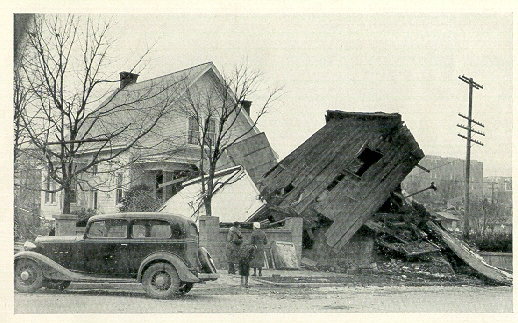
|
| Main and Third Streets. Showing park in Newtown, and cars hich had been completely submerged. | A winter's supply of kindling wood delivered free of charge at the front door. |
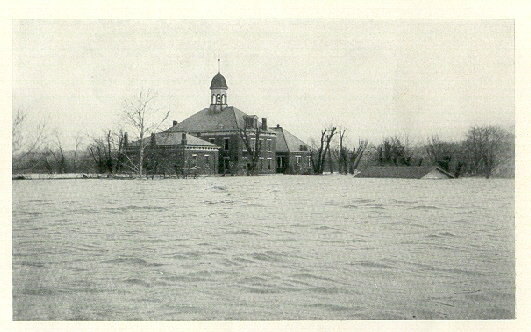 | 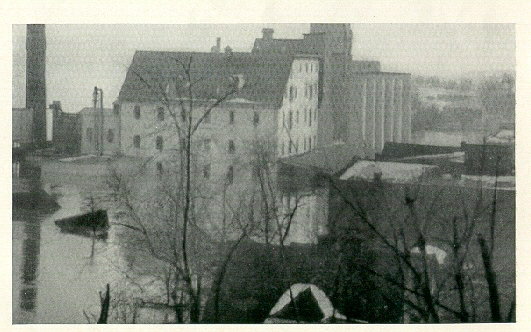
|
| The Lawrenceburg High School Building. | The Lawrenceburg Roller Mills are the largest flour mills in Indiana. |
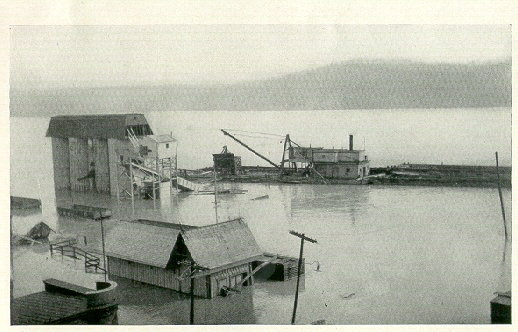 | 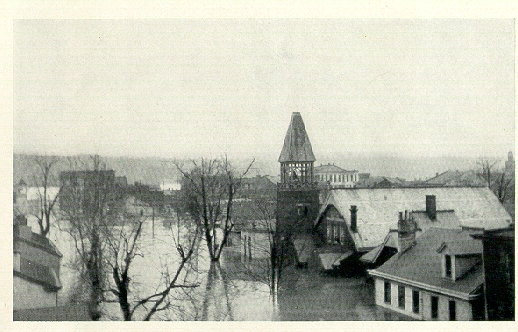
|
| People's Coal Company. Big Four Depot in foreground. | First Presbyterian Church on Short Street. Henry Ward Beecher was once pastor of this church. |
 | 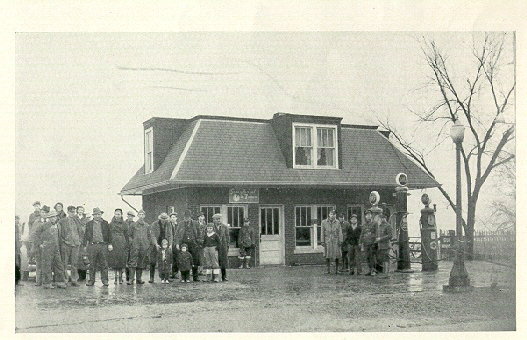
|
| Emanual Lutheran Church on Main Street. | This Filling Station near the boundary line between Lawrenceburg and Greendale was the only building in Lawrenceburg that was out of the water during the flood. |
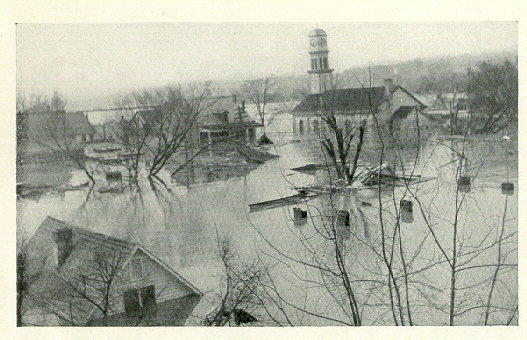 | 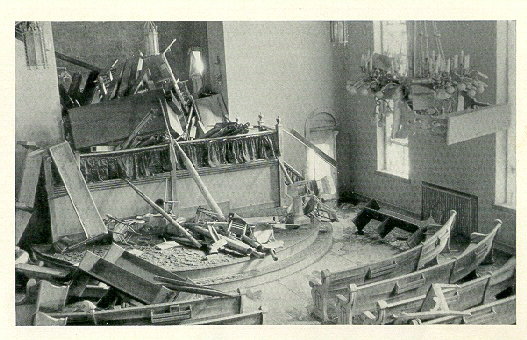
|
| View taken from Moon and Shopmeyer Building. | Interior of Zion Evangelical Church after water had performed its dreadful work. |
 | 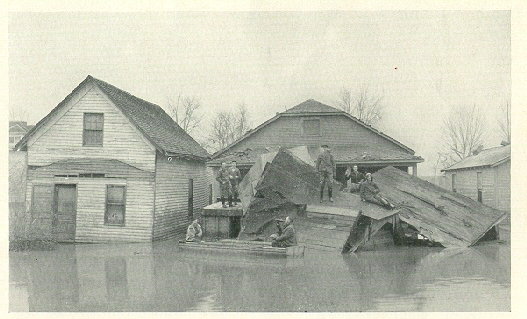
|
| Guilford Road. Had this road been constructed over the hills to the right, Greendale would have had direct communication to the outside world by automobile. | Some people refused to appear sad although their life's savings had all but vanished. |
 | 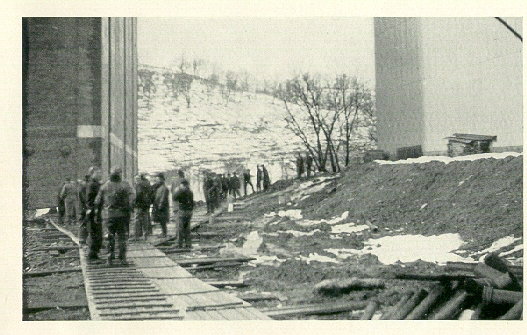
|
| Seagram Distilleries from Ludlow Hill. The Jos.
E. Seagram Distilleries were placed at the disposal of the refugees, and the unceasing efforts of its officials for the comfort of the distressed will make history never to be forgotten | THE LONESOME ROAD. Down this cleated board walk many a sad heart sighed, and many tears were shed as women and children refugees evacuated Greendale, across ugly waters, into the snow clad hills beyond, they knew not where. |
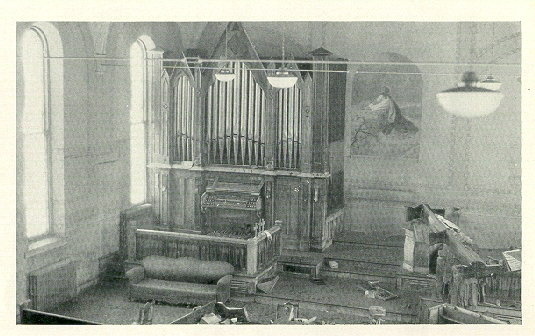 | 
|
| Emanual Lutheran Church, showing results of the flood. (Front of Auditorium) | Interior of St. Lawrence. Even God's edifices were not exempte from the terrible ravages of the flood. |
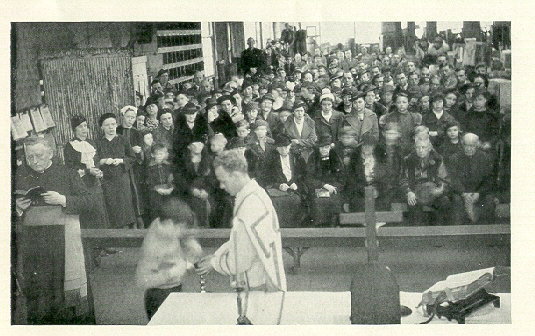 | 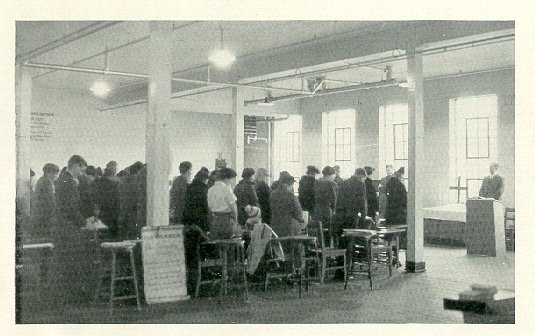
|
| Many of the faithful attended Mass in the A.D. Cook Foundry, February 7th. | Lutherans conduct services in the Old Quaker Bottling Plant. |
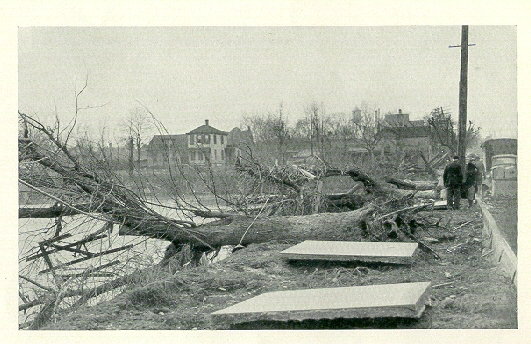 | 
|
| The "High Road" between Oldtown and Newtown, was nearly destroyed by the swift current of the Miami. | Treasure seekers. Many curious people poke around in the debris hoping to find something of value. |
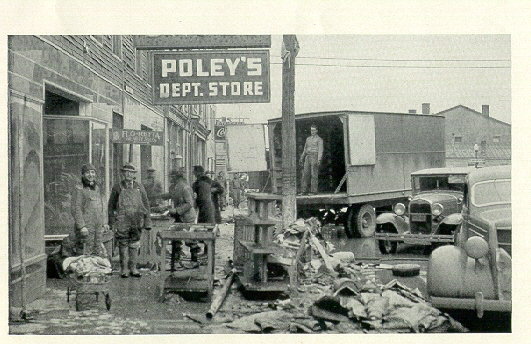 | 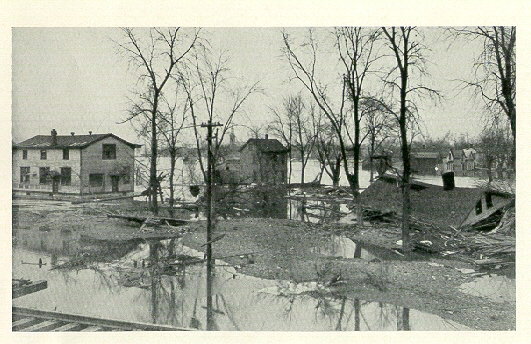
|
|
No sooner had the water receded than progressive merchants were back making ready to resume business. | At the west end of Center Street most of the houses were washed down the river by the terrible rush of water when the levee broke. |
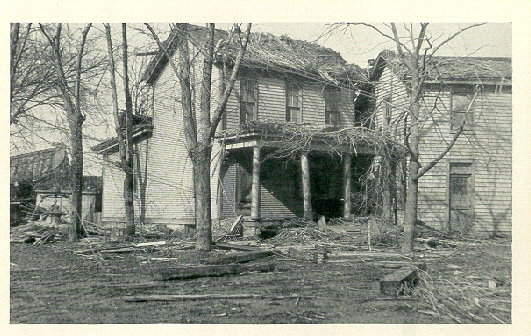 | 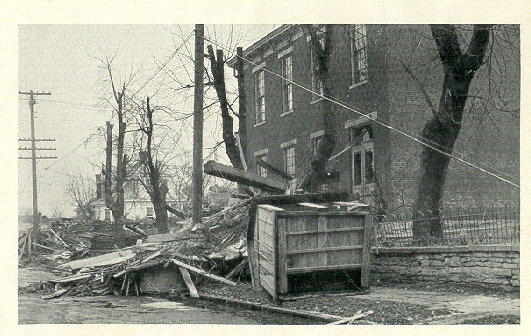
|
| A residence that stood the ravages of the flood was well built indeed. | Lawrenceburg had no sewer system, and many a building of the late Chick Sales architecture was moved from its foundation sometimes decorating a fashionable front yard. |
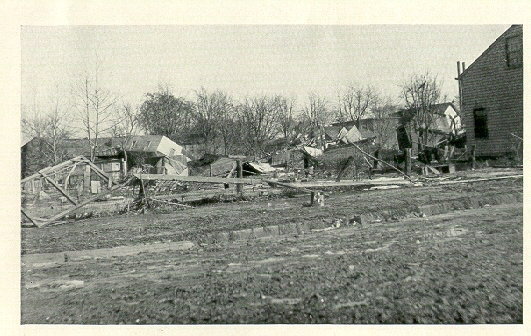 | 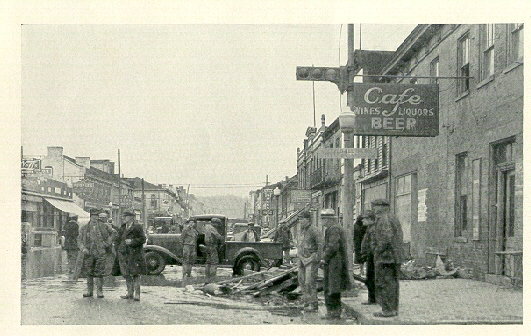
|
| A typical view on Shipping Street. | Corner of Walnut and Center Streets. The refreshment places and Beer Saloons are among the first to reopen. |
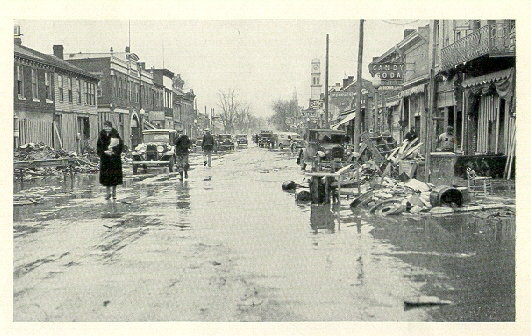 | 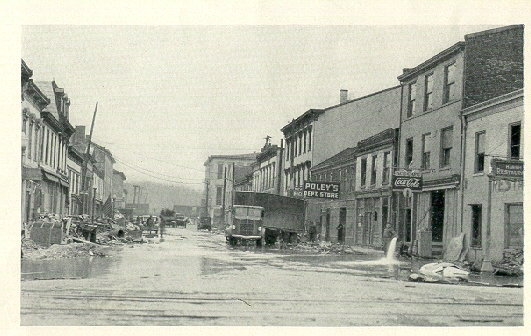
|
| What to do with refuse thrown out on the street was a real problem. | "You can't keep a good man down" and you can't keep a good town under. Lawrenceburg shall rise again. |
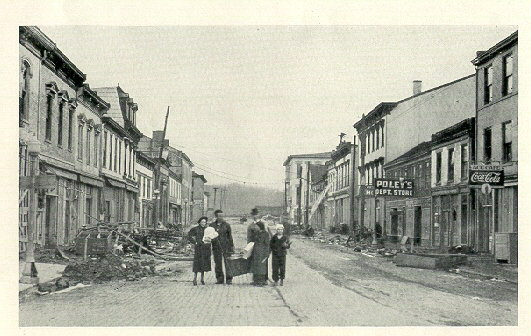 | 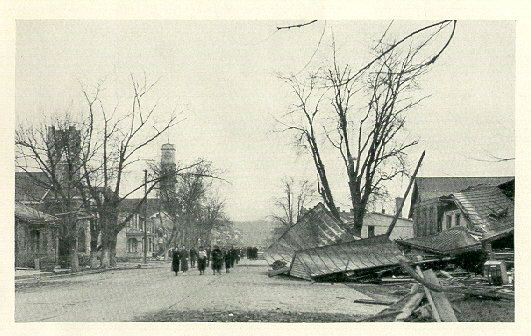
|
| Walnut Street looking toward the river. This family seems to be carrying their only earthly possessions | The many curious sightseers who invaded the city soon had to be prohibited. |
 | 
|
| "Photographs tell the story" but not vividly enough. They cannot convey the sickening sense of stench, filth and slime, nor the psychic sense of sorrowing hearts. | Many autos were abandoned, and now are buried in the mud, slime and filth. |
 | 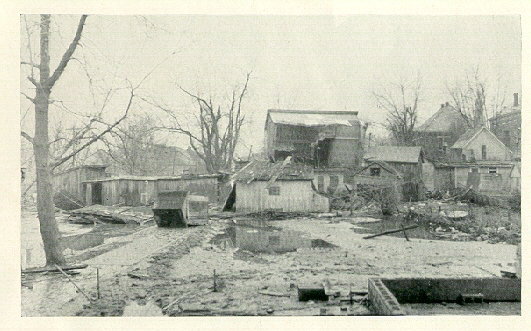
|
| Houses tumbled like tenpins. | The upended house in the distance formerly stood on the foundation at the right. |
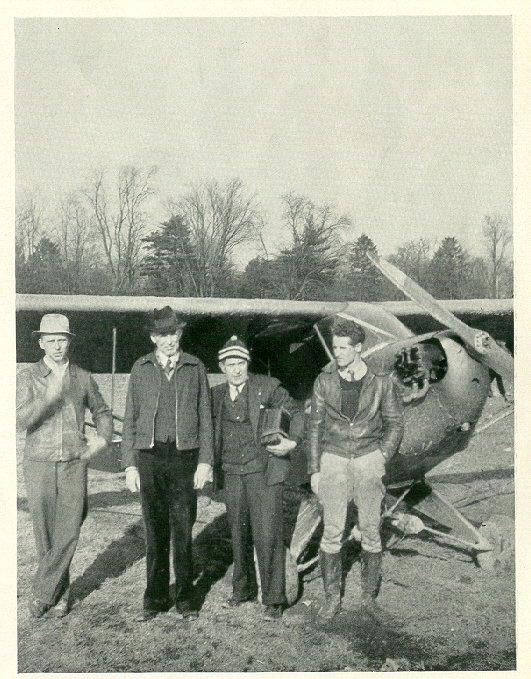 |
|
Picture taken just before Mr. Whitney went up in the plane to take the pictures. From left to right, E. C. Bearden, owner of the plane; Bernard McCann, editor of the Lawrenceburg Register; Mr. Whitney; and the pilot, James Hennessy |
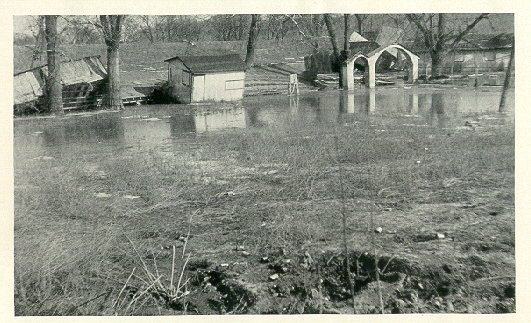 | 
|
| Entrance to Fair Grounds, and the Fair Grounds so recently expensively improved sustained extensive damage. | Corner Mary and Center Streets. Some houses managed to remain upright, but many crashed and crumbled. |
 | 
|
| Shipping Street was nearly demolished. | The A.D. Cook Company established an eating place under supervision of The Red Cross, for employees and victims of the flood. |
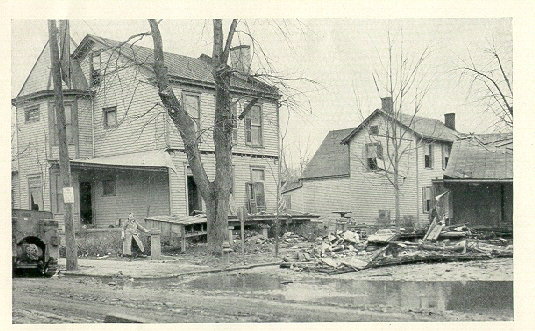 | 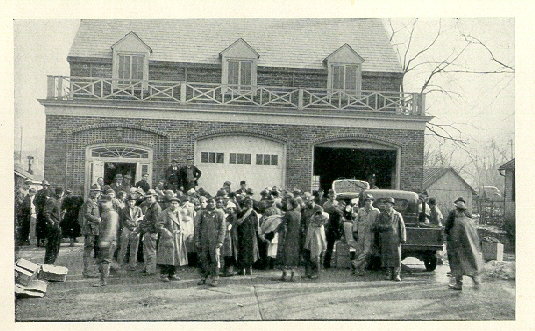
|
| Just one more courageous home owner salvaging as much as possible | Community House, Greendale. An anxious but good natured crowd always awaited the opening of the Commissary each morning. |
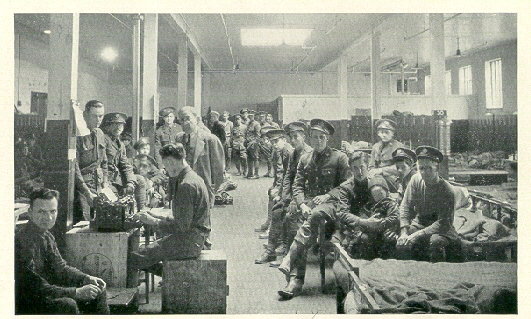 | 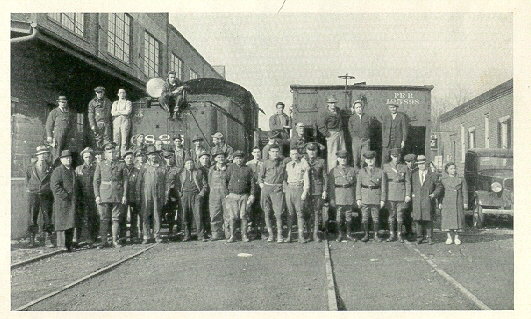
|
| Barracks in Old Quaker Bottling House. The State Militia was a great and helpful factor in keeping order, and establishing system in distribution of food and clothing. | Locomotives furnished steam heat for the Old Quaker Bottling Plant while the fires in heating plant were extinguished by high water. |
 | 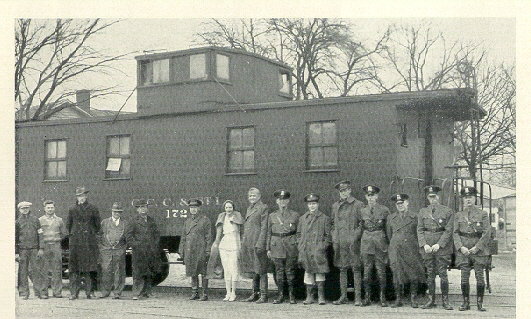
|
| Showing a part of the improvised hospital established in the Old Quaker Bottling House. | Caboose No. 172. During the height of the crisis, Col. Nanz and some of his valiant Lieutenants made sleeping quarters in 172 while their own beds were occupied by flood sufferers. |
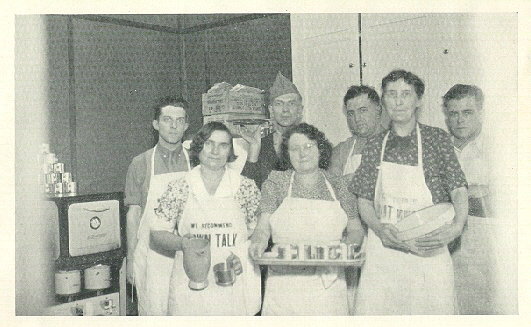 | 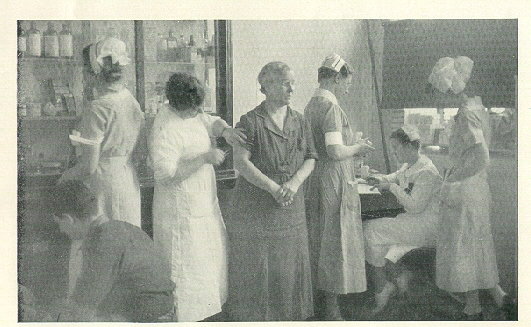
|
| These people gave freely their help in serving food to homeless refugees in the eating place of the Old Quaker Main Office Building. | Emergency dispensary established in The Old Quaker Bottling Plant |
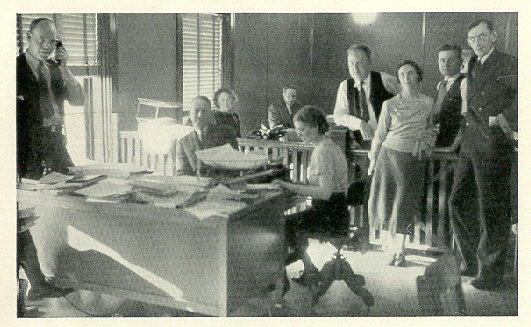 | 
|
| Lawrenceburg Roller Mills established offices in Old Quaker Office Building, while having their own building renovated. | Even refugees feel the need of a haircut during the flood. |
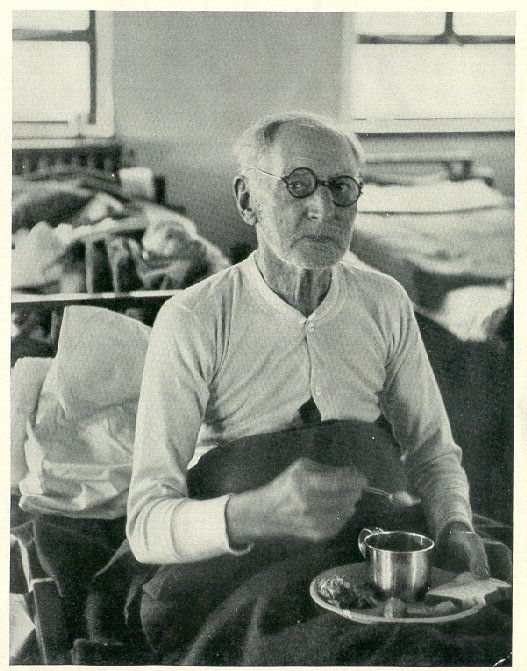 |
|
Phil Emmert, the last refugee to be taken (by force) from Oldtown. Eating breakfast in "The Seagram Hospital". |
 | 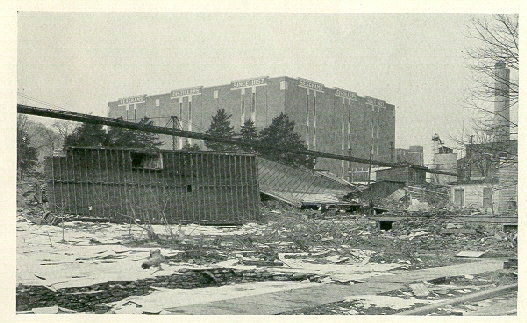
|
| he versatile officials of the Seagram Distilleries used two locomotives to furnish steam heat when the fires in the furnaces were extinguished by high water. | Many houses though rolled and tumbled about by the angry Ohio, stayed intact even when upside down |
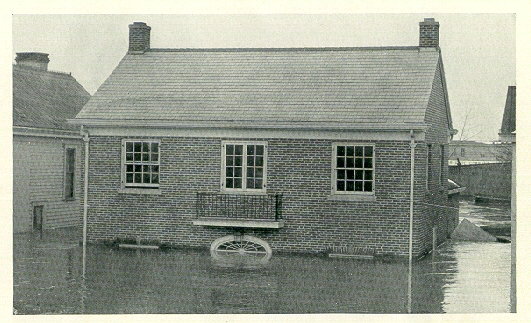 | 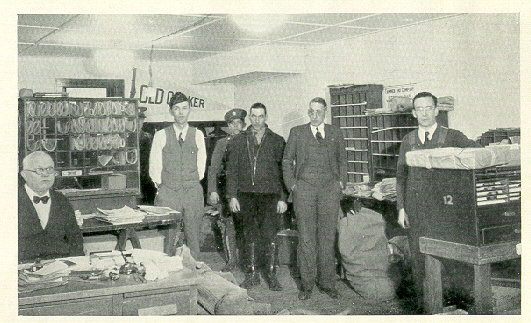
|
| The new building of the Southern Indiana Telephone Company withstood the flood, but not without great loss to the company. | While the new $50,000.00 Post Office was nearly covered with water, Postmaster Spanigal established a temporary Post Office in the Old Quaker Office Building.Post Office in the Old Quaker Office Building. |
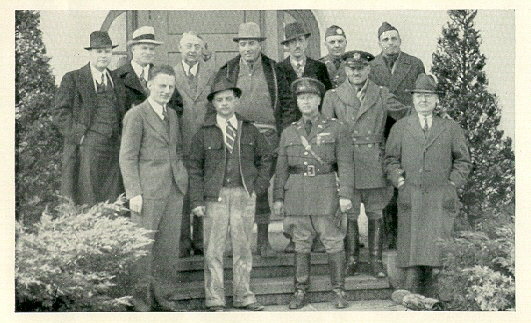 | 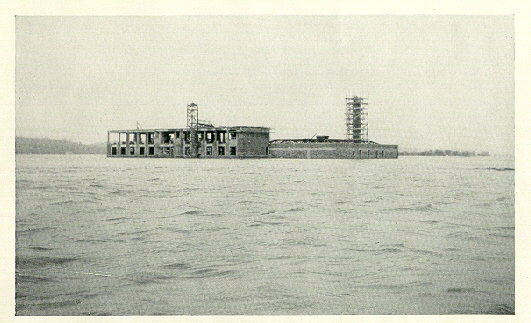
|
| The Governor's Party. Governor Townsend, on visiting Lawrenceburg, the last stricken city on his tour of Indiana cities on the Ohio, remarked, "All the rest are bad enough, but Lawrenceburg is a ghost city." The Governor is in center of upper row. This picture was made in front of Cornelius O'Brien's esidence. | The new High School Building under construction. Like an Island Prison it stands out a grim spector of the awful disaster. |
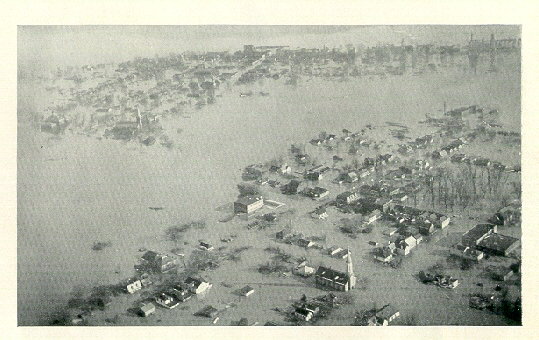 | 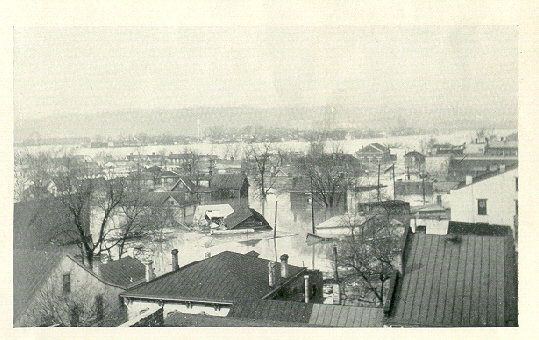
|
| Air View. Newtown in foreground. Oldtown in distance. | View from Odd Fellows Building. Looking toward Greendale, Jos. E. Seagram Distilleries in distance. |
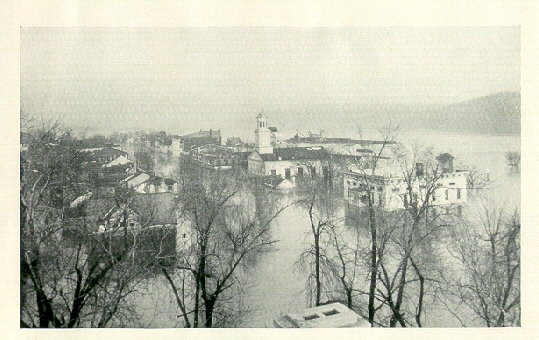 | 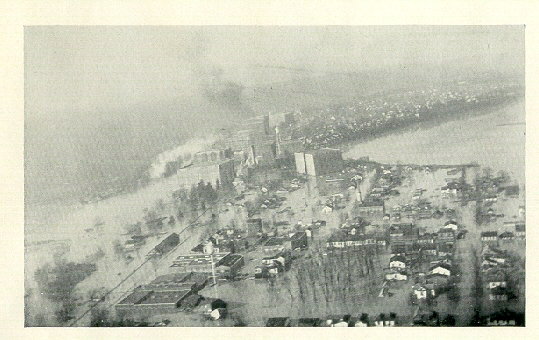
|
| View from Court House. The Legion Home can be seen at the right. | Looking North toward Greendale. Tanner's Creek on left, and the flats on the right. |
 | 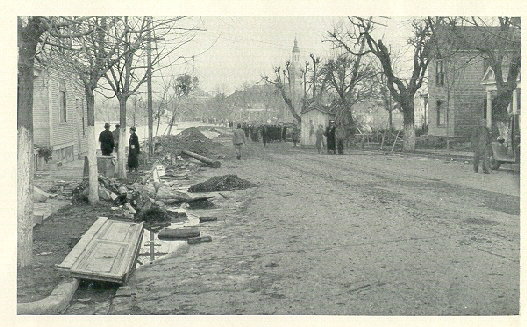
|
| Great destruction was done in "German Town". | Looking east on Third Street. Showing "High Road" washout. |
 | 
|
| Basements are rapidly emptied with gasoline engine pumps. | Looking west from Walnut Street toward the break in the levee. |
 |
| "Baby" George (Quaker) Hooten, whose life was saved by an improvised oxygen tent by Old Quaker Company employees. A trust fund of $2,000.00 is being raised for his education. Pictured above are Col. Nanz, little Georgie, and nurse Higgins of the Old Quaker Hospital. |
 | 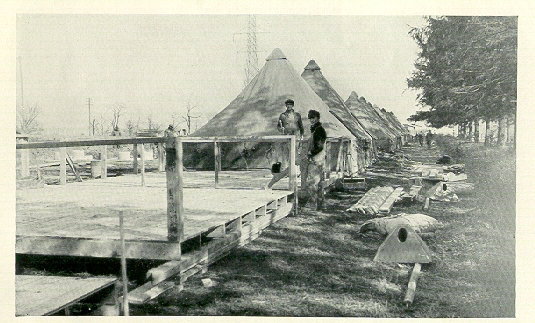
|
| The beginning of "Tent City" which, when completed, will consist of upward of four hundred tents, 16 1/2 feet square, furnished with table, cots, and chairs, a utility stove, serving for heat, cooking, and laundry purposes. | A welcome contribution by The Red Cross. |